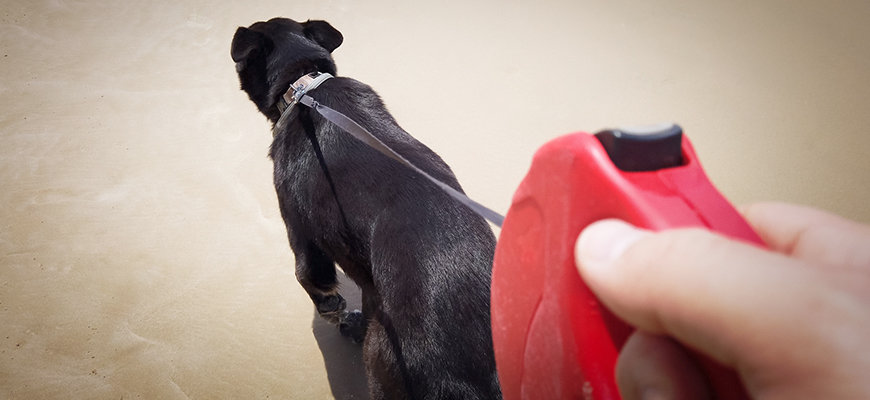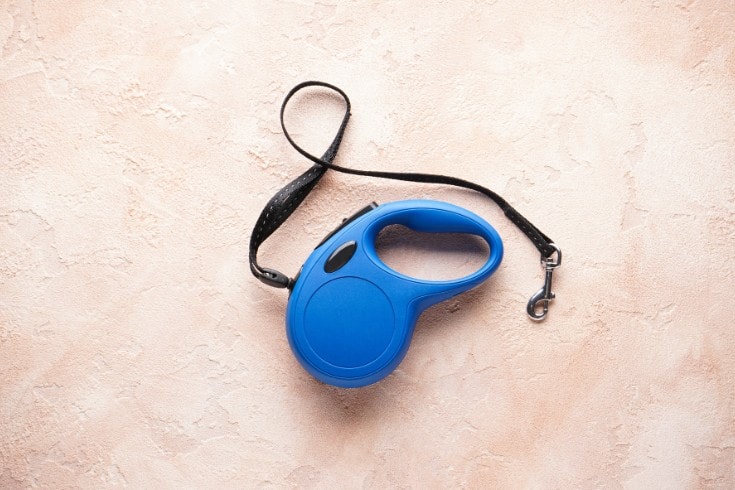You’ve been out for a walk with your pup and you find that you have a broken leash. The handle won’t pull back in and your pup can’t roam freely anymore. It may seem like a disaster, but don’t worry! Fixing this problem is much easier than it looks! Let’s look at why the leash isn’t retracting and how to fix it.
What Makes a Leash Retract?

Let’s look at what makes a retractable leash retract and some of their common issues. The most common types of retractable leashes like Flexi Leash have a spring mechanism inside which allows you to pull towards you and allow length for your pup to roam.
Sometimes when your leash isn’t retracting anymore, there may be dirt or hair in the mechanism causing it to get stuck.
With this spring system, over time, the parts may become worn or damaged due to misuse or regular wear and tear. Keeping your leash working properly is a must, so we need to understand how the leash works and how to take care of it.
How to Fix a Leash That’s Not Retracting
As I mentioned above, likely there is dirt, debris, or hair stuck in the spring mechanism. To clean this, make sure you know how to take it apart and put your leash back together. Take some warm water and a soft cloth or brush after dismantling and clean the spring.
Once done, put the leash back together, and voila! If all else fails, I suggest you take it apart multiple times to clean it and then reassemble it.
- Check the leash handle of the leash where the lead comes out and clean it to get rid of any debris or hair that might be stuck in there.
- Test it out to see if it retracts.
- If that doesn’t work, there are two screws near the handle portion, unscrew these and the 4 screws that are inside.
- This will open the leash for you to clean the insides out for any debris and hair.
- Replace the screws and test it out to see if it’s fixed.
- If after cleaning it doesn’t work, try cleaning it out even more.
- Test, repeat.
- If cleaning the inside doesn’t work for you, it may be time for a leash replacement.
- Be sure to check all the parts for wear and tear. You don’t want the leash to break or fall apart because of another bad part.
- Replace worn-out parts if you can and enjoy walks again!
With these simple steps, your retractable leash should be up and running again in no time! Properly caring for your lead will help extend its life span so you don’t have to worry about frequent leash repairs or replacements.
And if all else fails, there are plenty of other types of leashes available for training puppies or taking your furry friends on walks, such as traditional leads or harnesses.
How Long Should a Leash Last?

How long a leash should last you from the point of purchase depends on the type of leash. A retractable leash with a spring-based system should last you a while if properly taken care of – typically a few years. Most of them, however, are made with a plastic casing which can be a minor issue over time.
However, if the mechanism is constantly getting dirty or jammed, it may need to be cleaned or replaced more frequently. Other types of leashes, such as traditional leads or harnesses, typically last much longer and don’t require the same level of maintenance.
What Alternatives Are There to Retractable Leashes?
When choosing a dog lead, it’s important not only to consider your pup’s size but also their personality type; different leashes work better for certain types of dogs than others.
For example, some breeds do best with traditional collars or harnesses while others require more specialized equipment like head halters or no-pull options such as front clip harnesses.
Retractable leashes are great for pups who love exploring because they allow them more range of motion without sacrificing safety. Whatever type of lead you choose for your pup, make sure that it fits comfortably around their neck without being too tight or loose.
If in doubt, consult with a professional trainer who will provide personalized advice based on your pet’s individual needs.
Alternatives to a retractable leash can include:
Do Vets Recommend Retractable Leashes?
Well, that depends on which vet you ask! Some vets may recommend them, while others may not. The chief argument against these leashes is that they allow your pup too much freedom and can lead to injuries if they run too quickly or get tangled up with other dogs or people.
For this reason, it’s important to use caution when using them and always monitor your pup while they are exploring off-leash.
Do Dog Trainers Recommend Retractable Leads?
The answer here again depends on who you ask! Some dog trainers recommend retractable leads, as they can provide your pup with some extra freedom while still maintaining some level of control over their movements. However, most trainers advise against using them.
This is because it’s easier to train and maintain a hold on your dog while they’re on a traditional leash. There are plenty of dangers that can happen with a retractable leash, so you have to be vigilant.
Is a Leash Tape or Cord Better on a Retractable Leash?

The type of material used in the retractable leash can affect its performance. Tape-style leashes are better for small dogs as the tape is less likely to cause injuries if your pup pulls too hard. Cord leashes offer more control for larger dogs who need a more heavily-rated leash line in case they pull. I prefer tape retractables if I have to use them.
Too many people reach to grab the cord of the leash when trying to reel in an unruly dog. This can cause serious injury, especially with the corded retractable. Never grab the tape or cord with these single cord-style leashes!
What Is the Best Length for a Retractable Dog Leash?
Retractable leashes come in a variety of lengths ranging from 3 to 26 feet long, so it’s difficult to decide which length is ideal for your pup. Shorter lengths (3-10 feet) are best for smaller breeds, while longer lengths (14-26 feet) are better suited for larger breeds and active pups.
Conclusion
With these simple steps, your retractable leash should be up and running again in no time! Properly caring for your lead will help extend its life span so you don’t have to worry about frequent repairs or replacements.
And if all else fails, there are plenty of other types of leashes available for training puppies or taking your furry friends on walks, such as traditional leads or harnesses. So don’t worry if your retractable leash isn’t working anymore – just follow these steps for an easy fix!


